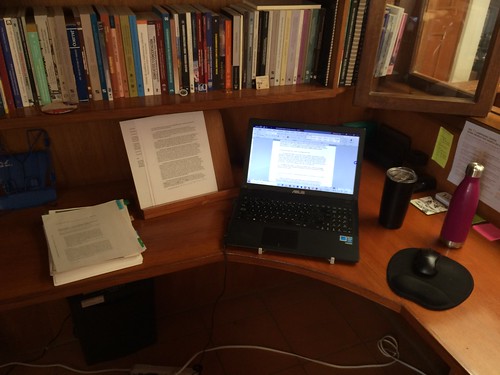This blog post focuses on using backcasting techniques and Overview Devices to revise the doctoral dissertation (chapter by chapter and/or the full draft). Applies to any thesis, for that matter. You can also extrapolate my strategy to revising a book manuscript as well (edited or solo author).
Recently, a doctoral student asked me “Professor Pacheco-Vega, how can I revise the full draft manuscript to a state where my advisor and committee can/will want to read it?”.
Well, first off, advisors and committee SHOULD always want to read it, regardless of its state. But I understand the question. This is the ages-old issue of “when is my writing good enough for someone else to read it?” When I was younger, I was MUCH more of a perfectionist than I am right now (and by God, I AM a perfectionist, and no, I’m not gloating, it’s a flaw!)
I think that a basic standard for “can it be read by someone else” could probably be “doesn’t have typos, nor blatant grammatical errors, and has been at least looked at by someone else for consistency, coherency and articulation”.
Having said that, I also recognize that getting to THAT point is really hard. Personally, I know I sometimes send stuff that is NOT yet up to the highest standard because I am tired of it, and it’s better to have it reviewed than not. But I do try to make sure that there is enough material to work with, for review.
Anyhow, regardless of standards, it is MUCH easier for me as a thesis advisor to react to SOMETHING. So yes, sometimes I do ask my students to send me rough drafts, scattered notes, etc. Not everyone is me, and I do this to help my students overcome their fear of producing text.
At any rate, what I tell my students when they finish their theses is to just send me the entire draft AS IS. This document may have gaps, holes, and some errors. But at least I can react to it.
There are 2 stages of revision of a first draft:
1) First draft to READABLE draft.
2) Readable draft to REVISED FIRST DRAFT (after being reviewed by supervisor/mentor/advisor)
The first (getting a draft to the readable point) usually involves hiring an editor or a trusted friend to provide help with grammar/typos/structure, etc. IF you want to do it alone:
Ok, so let’s assume your draft is in readable form (you’ve done the first round of revisions). Now, you send it to your advisor/committee and get a metric tonne of comments back.
You can use my Drafts Review Matrix, and adapt it for your dissertation https://t.co/kjfJikTGqR
— Dr Raul Pacheco-Vega (@raulpacheco) March 3, 2021
I recommend using these three Overview Devices
The Dissertation Two Pager (DTP) https://t.co/gy2nCKXAWw
The Dissertation Analytical Table (DAT) https://t.co/VH5e7SM8uW
The Global Dissertation Narrative (GDN)https://t.co/f4W9Tc6Rq4
My own students (and many others) use them
— Dr Raul Pacheco-Vega (@raulpacheco) March 3, 2021
In theory, you should have relatively few problems revising the thesis structure/argument if you have used my Overview Devices because you have maintained control over your text https://t.co/ZQDDHrghSs
— Dr Raul Pacheco-Vega (@raulpacheco) March 3, 2021
In short:
1) Revising Draft 1 to Readable Draft 1:
– check for structure, argument, typos, grammar, flow (use Pat Thomson, Rachael Caeley’s blog posts)
2) Revising Readable Draft 1 to Shareable Draft (for external readership, AFTER advisor’s comments)
– use DRM, GDN, DAT, DTP
Most advisors (mine did) prefer to read a draft and provide comments back BEFORE letting their students share with the committee (most committee members will want drafts they read approved by advisors). I prefer this strategy too (thus obtaining the “stamp of approval”)
When I teach my students how to use Gantt Charts to plan and track their progress, I always tell them to include buffer time for revisions and to allow enough time for committe members to read and provide feedback (WITHIN REASON). https://t.co/YLCm2x6AMW
This is key.
— Dr Raul Pacheco-Vega (@raulpacheco) March 3, 2021
All professors I know are overburdened, so it’s a good strategy to (a) inquire how much time they need (b) whether it is ok to send them a reminder that you need your draft back and (c) provide a roadmap of changes you’ve made/progress you have achieved, maybe include the DTP.
Obviously, supervisors and students will need a strategy for when advisors/committee members may not be as responsive as a student might need (deadlines, etc.) – I wish I had a good suggestion for this, but mostly, what I tell students is to maintain healthy dialogue w/advisors.
Students/graduate researchers may also want to include a copy of their DRM when providing a new draft (“I made these changes, I did not make these other ones because they didn’t apply/fit, etc.”) I always ask my students to send me their DTP alongside any new draft, so I can see how their thinking is evolving. I also usually ask for DAT and GDN as well.
Hopefully this strategy will be useful to my readers!


0 Responses
Stay in touch with the conversation, subscribe to the RSS feed for comments on this post.